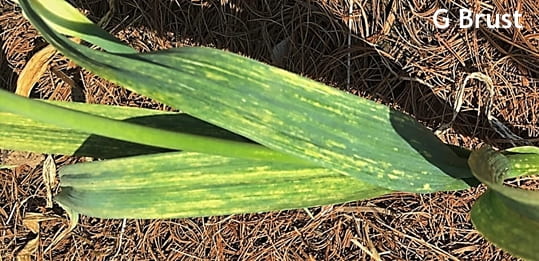Jerry Brust, IPM Vegetable Specialist, University of Maryland; jbrust@umd.edu
In the past I have talked about several different problems with garlic, be it mites, nematodes, fungal or bacterial diseases. However, this year I am seeing something different that I will just call ‘garlic viruses’ that may have been there in past years, but is more prominent now for some reason. Symptoms of virus infection are plants that display yellowing tips on many leaves with some that are completely yellow (Fig. 1). If you look closely at the yellow leaves you’ll see mottling or striping on the leaves (Fig. 2). Symptoms are usually more pronounced in young leaves. Infected plants are stunted and bulb size can be reduced. Garlic crops infected with some of these viruses are more susceptible to weather conditions like frost, and do not keep well in storage.
What I am calling garlic virus is caused by several different viruses that can be grouped under the term “potyvirus”–the garlic we tested was positive for potyvirus. Some people lump these viruses under the name “garlic mosaic”. In this case garlic mosaic can be thought of as a disease caused by one or more viruses belonging to the potyvirus group, which includes onion yellow dwarf virus, leek yellow stripe virus, and others. These viruses can be transmitted through the planting stock or by aphids and it is thought by some that because garlic is clonally propagated that much of the planting stock is infected with some type of virus. These viruses are usually mild and do not affect yield to any great extent. The problem comes when the plants are infected with several different potyviruses, and then there can be moderate to severe yield reductions. For instance, when infected with 2 or more potyviruses yield loss in garlic bulbs can be as much as 70% or germination rates can be reduced by 55%. Some hosts of these potyviruses include: garlic, great-headed garlic, leek, pearl onion, wild garlic, onion and shallot. The two most common aphid vectors are the green peach aphid (Myzus persicae) and the black bean aphid (Aphis fabae).
Management Usually virus infections are not a problem, but for this season they seem to be more prominent. We will need to see if this is an aberration or a trend. If the frequency of the virus continues then growers will need to move to virus-free stocks that are produced from meristematic tip culture. The use of this “virus-free” stock should result in significantly greater yields.
Figure 1. Garlic plants showing symptoms of garlic virus infection
Figure 2. Streaking and striping on leaves of garlic infected with virus


